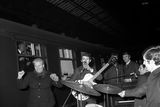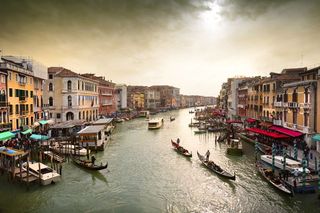The Thin White Duke's secret passion for Irish artist Yeats
It's well-known David Bowie had a love of art, but the fact his collection - due to go under the hammer soon - included a Jack B Yeats painting, has surprised many
Art decade: David Bowie pictured in 2013
David Bowie may have been pop's great shapeshifter, but throughout his life there was one constant: a deep love of art. Seven months after his death, this week it was announced that some 400 works from the Thin White Duke's private collection are to be auctioned at Sotheby's in London, and are expected to fetch more than €15m. Among the pieces is an important painting by the Irish artist Jack B Yeats. 'Sleep Sound' is an oil-on-canvas depicting two figures laid on a moor, valued at €200,000.
That Bowie, who died of liver cancer in January at age 69, would be an admirer of an early 20th-century painter such as Yeats, is regarded as a surprise. The singer's passion was modern and contemporary British and American art - though Sotheby's has suggested Bowie might have been drawn to 'Sleep Sound' because of the Irishman's "independent spirit".
"In Yeats he found a pioneering and explorative artist that reflected his own creative impulses," said a Sotheby's representative, who described 'Sleep Sound' as "bordering on the abstract, with sky, land and figures merging into one and stimulating the eye to dart across the surface".
Yeats, the younger brother of the poet WB Yeats, painted the piece in 1955, two years before his death. Its whereabouts had been a mystery and there was shock in the Irish art world when it surfaced in the Bowie collection. It was originally owned by the American art collector Eleanor de Bretteville Read, who happened upon it in an San Fransisco antique shop, and was purchased anonymously by Bowie at Sotheby's in 1993 for the equivalent of €50,000.
That would have represented loose change for Bowie, whose net worth at his passing was $230m. Wealth allowed him indulge in his passion for art - to which he brought considerable expertise: among the pieces up for auction at Sotheby's are works by Frank Auerbach, Auerbach's tutor David Bomberg and Harold Gilman. The highest valued work to go under the hammer will be 'Air Power' by the late Jean-Michel Basquiat, anticipated to raise up to €5m (Bowie played Basquiat's mentor, Andy Warhol, in a 1996 biopic about the Brooklyn wunderkind, who died of a heroin overdose age 27).
"It's such an erudite and intellectual collection. There's a cohesiveness to it," Tom Eddison, a contemporary-art specialist at Sotheby's, said this week. "[Bowie] is incredibly well-tuned into art and artists."
Bowie's fascination with art predated his pop career. Back when he was plain old David Jones, he studied painting at Bromley Technical School in London. There, he befriended George Underwood, later to become an artist and designer of several Bowie album covers (it was also Underwood who, punching Bowie in the face during a row, would leave the singer with a damaged iris that made it appear as if his eyes were different colours).
That Bowie was himself terrible at painting seemed both to inspire him to become a musician and fuel his interest in art. "I've always loved George's work. I think he may have unconsciously tipped me towards music," Bowie would say. "Sitting alongside him… convinced me (among others) that I would never achieve his fluidity of lines, his sense of rightness in relation to his subject… whatever it was."
Yet while Bowie's deep affinity with the visual arts will doubtless deepen his mystique, in Ireland the forthcoming auction may give pause. The expectations of record sums being raised at the Bowie auction demonstrates that the international arts market is again booming. In Ireland, this will bring uncomfortable memories of the most recent bubble, when the art scene fell victim to the same over-exuberance that would devastate the housing market.
The degree to which the sector was overinflated is illustrated by Nama's struggles to offload the collection of a financier: in 2011, the national debt management agency offered the collection at Christie's for €2m and failed to find a taker; two years later, the lot went under the hammer again, at a 50pc mark-down.
However, with the economy on the upturn, collectors are opening their wallets once more. At an auction in the RDS last year, an oil-on-canvas by Louis le Brocquy went for €78,000, while 'Connemara' by Paul Henry fetched an eyebrow-raising €66,000. Internationally, too, demand for Irish art is on the rebound, with Sotheby's, which had quietly shuttered its "Irish Sale" during the recession, reinstating the annual showcase.
"Demand from collectors of Irish art from outside Ireland has increased," said the house ahead of an auction last October, at which John Lavery's Japanese Switzerland fetched nearly €693,000 - circa €20,000 higher than the estimate.
"If you have two or three thousands euro to spend, you may see art as a good option," said one person with deep knowledge of the market in Ireland. "You read that banks are charging people for deposit accounts - and suddenly art looks like a good investment.
"We are also seeing interest from the US, a lot of Americans are snapping up Irish homes and they want Irish art to go with it. There is great buoyancy. We are in no way approaching what happened from 2005 onwards. It is more gradual."
Two opposing forces may have contributed to the upswing, suggest experts. Those who paid over the odds for pieces during the Celtic Tiger are continuing to offload work and free up cash; meanwhile collectors who feel bargains are to be had are getting back into the market.
"Overall, the work of individual Irish artists, other than a few with international reputations, has not increased significantly in value; and in many instances has still not achieved Celtic Tiger prices," says art consultant and historian Derville Murphy.
"Arguably, the increase in sale volumes is being driven by improving consumer confidence in the market generally, particularly from the sellers.
"It also reflects the pent-up supply from owners still struggling to meet mortgage commitments and wishing to sell those assets they bought at inflated prices during the boom years.
"Correspondingly, there is also an audience who believes there are bargains to be had in a rising market, and this may be true for certain discerning and knowledgeable buyers." Yet there has also been a shift from visual art to high-value collectables, such as furniture, she says.
"During the last decade, the art market has fundamentally changed. For domestic consumers of art, affordable interior furniture and fittings that represent aspirational lifestyles have changed how many young professionals view art.
"They would question an investment in expensive traditional artwork, regardless of style or subject, in the knowledge that they are likely to redecorate and refurnish their homes every five years or so. These young investors are as likely to spend that disposable income on a reproduction Eames chair, Orla Kiely cushions..."
As for Bowie, some in the art world have expressed disappointment that his estate is putting so much of his collection under the hammer. Is that truly as he would have wished?
"I had heard rumours [about the sale] earlier this year, but I hoped they would change their minds," Bernard Jacobson, a London gallery owner and friend of Bowie, told 'Newsweek'.
"[This collection] was David's love affair, his passion."
Join the Irish Independent WhatsApp channel
Stay up to date with all the latest news














